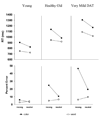The utility of Stroop task switching as a marker for early-stage Alzheimer's disease
- PMID: 20853964
- PMCID: PMC2946107
- DOI: 10.1037/a0018498
The utility of Stroop task switching as a marker for early-stage Alzheimer's disease
Erratum in
- Psychol Aging. 2010 Dec;25(4):778. Ducheck, Janet M [corrected to Duchek, Janet M]
Abstract
Past studies have suggested attentional control tasks such as the Stroop task and the task-switching paradigm may be sensitive for the early detection of dementia of the Alzheimer's type (DAT). The authors of the current study combined these tasks to create a Stroop switching task. Performance was compared across young adults, older adults, and individuals diagnosed with very mild dementia. Results indicated that this task strongly discriminated individuals with healthy aging from those with early-stage DAT. In a logistic regression analysis, incongruent error rates from the Stroop switching task discriminated healthy aging from DAT better than any of the other 18 cognitive tasks given in a psychometric battery.
(c) 2010 APA, all rights reserved.
Figures


Similar articles
-
Predicting conversion to dementia of the Alzheimer's type in a healthy control sample: the power of errors in Stroop color naming.Psychol Aging. 2010 Mar;25(1):208-18. doi: 10.1037/a0017474. Psychol Aging. 2010. PMID: 20230140 Free PMC article.
-
The utility of intraindividual variability in selective attention tasks as an early marker for Alzheimer's disease.Neuropsychology. 2009 Nov;23(6):746-58. doi: 10.1037/a0016583. Neuropsychology. 2009. PMID: 19899833 Free PMC article.
-
Effects of healthy aging and early stage dementia of the Alzheimer's type on components of response time distributions in three attention tasks.Neuropsychology. 2010 May;24(3):300-15. doi: 10.1037/a0018274. Neuropsychology. 2010. PMID: 20438208 Free PMC article.
-
Attention and driving skills in aging and Alzheimer's disease.Hum Factors. 1991 Oct;33(5):539-57. doi: 10.1177/001872089103300506. Hum Factors. 1991. PMID: 1769674 Review.
-
Mild cognitive impairment in older adults.Curr Psychiatry Rep. 2012 Aug;14(4):320-7. doi: 10.1007/s11920-012-0291-x. Curr Psychiatry Rep. 2012. PMID: 22773365 Free PMC article. Review.
Cited by
-
The effect of three months of aerobic training on stroop performance in older adults.J Aging Res. 2012;2012:269815. doi: 10.1155/2012/269815. Epub 2012 Dec 11. J Aging Res. 2012. PMID: 23304504 Free PMC article.
-
Frontal P300 asymmetry and congruence judgment: Retroactive switching is impaired during school day mornings in female adolescents.Curr Res Neurobiol. 2024 Mar 27;6:100128. doi: 10.1016/j.crneur.2024.100128. eCollection 2024. Curr Res Neurobiol. 2024. PMID: 38577062 Free PMC article.
-
Association between changes in habitual stepping activity and cognition in older adults.Sci Rep. 2024 Apr 5;14(1):8003. doi: 10.1038/s41598-024-58833-x. Sci Rep. 2024. PMID: 38580840 Free PMC article.
-
Decreased Alpha Peak Frequency Is Linked to Episodic Memory Impairment in Pathological Aging.Front Aging Neurosci. 2021 Aug 12;13:711375. doi: 10.3389/fnagi.2021.711375. eCollection 2021. Front Aging Neurosci. 2021. PMID: 34475819 Free PMC article.
-
Reaction time and response inhibition in autosomal dominant Alzheimer's disease.Brain Cogn. 2021 Feb;147:105656. doi: 10.1016/j.bandc.2020.105656. Epub 2020 Dec 10. Brain Cogn. 2021. PMID: 33310624 Free PMC article.
References
-
- Albert MS, Moss MB, Tanzi R, Jones K. Preclinical prediction of AD using neuropsychological tests. Journal of the international Neuropsychological Society. 2001;7:631–639. - PubMed
-
- Allport DA, Styles EA, Hsieh S. Shifting intentional set: Exploring the dynamic control of tasks. In: Umilta C, Moscovitch M, editors. Attention and Performance XV. Cambridge, MA, US: The MIT Press; 1994. pp. 421–452.
-
- Allport DA, Wylie G. Task-switching: Positive and negative priming of task-set. In: Humphreys GW, Duncan J, Treisman A, editors. Attention, space, and action: Studies in cognitive neuroscience. Oxford, UK: Oxford University Press; 1999. pp. 273–296.
-
- Allport DA, Wylie G. Task-switching, stimulus-response bindings, and negative priming. In: Monsell S, Driver JS, editors. Attention and performance XVIII: Control of cognitive processes. Cambridge, MA: MIT Press; 2000. pp. 35–70.
-
- Armitage SG. An analysis of certain psychological tests used for the evaluation of brain injury. Psychological Monographs. 1945;60:1–48. (1, Whole No. 177)
Publication types
MeSH terms
Grants and funding
LinkOut - more resources
Full Text Sources
Medical
Miscellaneous

